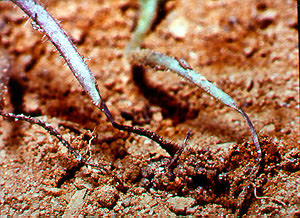Damping-Off
Damping-off is a common disease that kills seedlings in the greenhouse. Damping-off can kill both germinating seeds and young seedlings. Several fungi can cause this disease, including Rhizoctonia solani, Pythium spp., Phytophthora spp., Sclerotinia spp., and Botrytis spp. Most of these fungi can also cause cuttings to rot. These fungi are found in practically all soils and pose a large threat to plant propagation. Practically all species of plants can be affected.
Symptoms. Damping-off often is seen in round patches in seeding flats. Preemergence damping-off is a term used to describe the rot of seeds, or the death of the seedlings, before they emerge from the soil. Post-emergence damping-off affects seedlings that have already emerged from the soil. These seedlings may develop a dark stem rot near the soil surface which will cause them to fall over and die as the rotted area shrivels.


They may also rot from the tips of the roots. This rot will progress up the seedling until the stem is rotted. Seedlings that survive until they are a bit older before they are infected may develop "wire-stem", a condition in which the base of the stem is partially invaded by the fungus. There is often a discolored and slightly shriveled or constricted area at or just below the soil line. Although the plant lives for a while, it is stunted and pale, and often will eventually die. Brown or white fungal growth may be seen on the surface of the potting media or on the seedlings themselves.
Prevention. The best way to control this disease is to prevent it. There are many prevention techniques, and a combination of them is most effective.
One way to help prevent this disease is to keep the fungi that cause it out of the flats of seeds.
Plant seeds and root cuttings only in sterilized seedling mix or other planting media, using only sterilized containers.
Use only clean non-recycled water on the seeds.
Place seed trays on clean, sterilized benches.
Do not allow soiled hands and tools to come into contact with the sterile media. Reintroduction of the fungi can cause fast disease progression because other fungi which normally compete with these fungi are absent from sterile mixes.
Remove any trays with damping-off immediately.
A second way to help prevent this disease is to encourage the seeds to germinate and grow as fast as possible. Plants are only susceptible to damping-off as seedlings.
Use adequate light and heat to germinate and grow seedlings quickly.
Bottom heat may speed germination.
Avoid planting seeds too deeply.
A third way to help prevent this disease from causing huge losses (although some loss may occur) is to keep conditions in the seeding trays less favorable to the fungi. These fungi like wet conditions.
Use well-drained planting media.
Sow seeds thinly to allow air to circulate between seedlings.
Avoid excessive watering.
In addition to these measures, use fungicide treated seeds, and see current recommendations for chemical control measures. Seedlings of many plants may be adversely affected by fungicides. There is much current research on planting media that suppresses these fungi.
By Pamela S. Mercure, IPM Program Assistant, University of Connecticut, 1998
References.
Baker, R. 1985. Damping-Off in Diseases of Floral Crops, Volume 1. Chapter 1 Praeger, New York. D.L. Strider, ed.
Chase, A.R. 1995. Compendium of Ornamental Foliage Plant Diseases. APS Press, St. Paul, MN.
Daughtery, M.L., R.L. Wick, and J.L. Peterson. 1995. Compendium of Flowering Potted Plant Diseases. APS Press, St. Paul, MN.
Jones, R.K. and D.L. Strider. 1985. Bedding Plants in Diseases of Floral Crops, Volume 1. Chapter 1. Praeger, New York. D.L. Strider, ed.
This information was developed for conditions in the Northeast. Use in other geographical areas may be inappropriate.
The information in this material is for educational purposes. The recommendations contained are based on the best available knowledge at the time of printing. Any reference to commercial products, trade or brand names is for information only, and no endorsement or approval is intended. The Cooperative Extension system does not guarantee or warrant the standard of any product referenced or imply approval of the product to the exclusion of others which also may be available.All agrochemicals/pesticides listed are registered for suggested uses in accordance with federal and Connecticut state laws and regulations as of the date of printing. If the information does not agree with current labeling, follow the label instructions. The label is the law.Warning! Agrochemicals/pesticides are dangerous. Read and follow all instructions and safety precautions on labels. Carefully handle and store agrochemicals/pesticides in originally labeled containers immediately in a safe manner and place. Contact the Connecticut Department of Environmental Protection for current regulations.The user of this information assumes all risks for personal injury or property damage.Issued in furtherance of Cooperative Extension work, Acts of May 8 and June 30, 1914, in cooperation with the U.S. Department of Agriculture. Kirklyn M. Kerr, Director, Cooperative Extension System, The University of Connecticut, Storrs. The Connecticut Cooperative Extension System offers its programs to persons regardless of race, color, national origin, sex, age or disability and is an equal opportunity employer.
